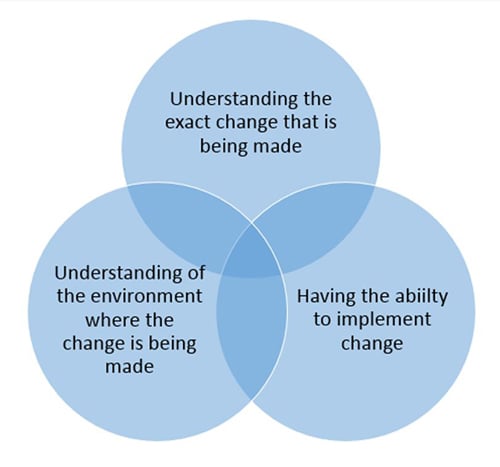About six months ago, I was asked to perform a presentation on what makes change successful. To prepare for this, I scanned literature, videos, social media postings, etc. in search of inspiration. Apart from discovering that an entire industry has been developed around change (e.g. consultants, training courses and books), I also realised that there is no ‘silver bullet’ or clear set of rules to follow to ensure that change is successful. I guess this is supported by Kotter, who said in 1995 that ‘only 30% of change programmes are successful’.
After thinking about this, I discovered three very high-level variables that need to be managed to try and implement successful change. As I started to develop these ideas, I quickly realised that the key to delivering change is the ability to cope with and manage uncertainty.
The variables are as follows:

Understanding the change environment
The first variable is to (try to) understand the environment where the change is going to be made. This is based on the logic that if you do not know your starting position, then how can you implement change to it successfully? However, understanding this is much easier said than done.
There will be tangible elements to consider. These will cover the internal business model (between departments and teams), as well as the external business models, such as with suppliers, customers and industry peers. Models could operate across borders, time zones and countries and cover myriad items such as process/workflows, products, regulations, technology, people, legal arrangements, and so on.
Also included will be internal and external influences. These elements will include the intangible, power / knowledge bases and cultural differences, as well as good / bad will with suppliers, customers and peers (reputation). The bottom line is that even for the smallest of businesses, the operating environment will be complex and therefore highly unlikely to be fully documented and / or totally understood.
There are also further issues. Different parts of the environment will be at different levels of maturity; for example, a supplier could be running manual systems whilst a client is fully automated. In addition, the environment is always changing, and certain aspects will be unknown (for various reasons, suppliers, customers, industry peers, etc. may not fully share their inner workings). This all adds to the various layers of complexity that need to be addressed within the change.
The irony is that, whilst an understanding of the environment is necessary to implement successful change, it is almost impossible to fully define and understand it. Therefore, it will be more of a case of understanding what it is you do know - and, more importantly - knowing what areas are unclear, so that they can be monitored during the implementation.
The change that needs to be made
The second aspect is understanding why the change is being implemented. This is based on the logic that if you do not know what change you have to make, then how can you implement it successfully, if at all?
However, there is often confusion between the ‘what’ and ‘how’, versus the ‘why’. For example, if a project is instigated to upgrade IT infrastructure, then the change being made is probably ‘upgrade the technology infrastructure to support the business growth’, not just simply ‘update the technology infrastructure’. Hence, it is vitally important to understand the 'why'.
This example also highlights the point of linking any change to the organisation's overall strategy - if nothing else, it will help understand why the change is being made, how it fits in with the bigger picture and whether the change is tactical or strategic. Once this is understood, then there are several practical issues to consider:
- Firstly, understanding what specifically needs to change. For example, the scope of the change and especially any unclear scope items that will need monitoring.
- Secondly, knowing the implications of the timescales - especially if they are classified as ‘cannot be missed’ (such as the implementation of new legislation), or are client driven. Again, any items that are unclear will need to be monitored.
- Thirdly, confirming the list of ‘areas’ impacted by the change. This could cover internal departments, customers, suppliers, products, technology, legal arrangements, etc. Once more, any items that are unclear need to be listed and monitored.
- Fourthly (and possibly the trickiest), is determining what the measure of success or failure actually is; then ensuring that all key stakeholders agree with these measures (and getting a consensus is often not that easy). Tangible measures, such as reduced cost by percentage, tend to be easier to measure. Intangible measures, including improving customer focus, are much harder (or nigh on impossible) to measure effectively. Any challenges with measuring success must be logged and monitored.
- Finally, once you have some sort of grasp on the above, then you can put the change structure in place. This will cover plan, budget, people, resources, issue management processes, communications, roles, controls, reporting, etc.
- There are two points to note: the first is ensuring that the ‘governance’ matches the change being made. If the governance is too heavy then it will prove onerous and ineffective; if it is too light, it may not control the change.
- The second point is that it may not be possible to secure all the budget, or the workforce required for the change, due to other funding priorities. If so, then this needs to be noted, although it is often a case of ‘just getting on with it’.
While it is important to understand the change being made, it is not always possible to document it. This can be due to vagueness around why change is required, the scope of what needs to change, deadlines, or measuring success / failures. The key point is to recognise that one cannot fully define a change; therefore, it is essential to understand the unknowns so they can be managed.
The ability to implement change
While it is important to understand the change being made and the environment in which the change is taking place, an organisation needs the ability to successfully implement change.
This area is often overlooked by organisations who tend to focus only on the narrow area of project management and forget the need to develop both the mindset and organisation-wide change capability. In effect treating ‘change management’ as an organisation capability in the same way organisations might have a marketing or sales function.
The capability has three main elements:
- Senior management support and communication
There must be consistent management support and direction for all changes being made. This will ensure people know what changes are in progress, why they are being made and how important they are. This support needs to be delivered with clear and consistent communication. - Human factors
Managing these factors is the most important part of change. If you do not manage this, then it could result in resistance, fear and suspicion. Your organisation’s culture must, therefore, support change. People need to feel involved, have the confidence to express ideas and feel motivated to make change happen. You should aim to involve impacted stakeholders so they understand how the change will affect them personally and (if possible) allow them to have an input into outcomes. - Process factors
Change is an ongoing activity, which means processes and structures are needed. At a senior level, you should have an organisation-wide committee to ensure you employ your limited change capacity on the most important changes. This committee should also provide guidance around prioritisation and track the progress of in-flight changes. At grassroots level, you should have a standard pan-organisational change process, which covers initiating change, planning change, executing change, closing change and managing the risks associated with change. You should also ensure that there is an organisation-wide change control process to review any changes to scope, timeline and the cost of a particular change, including the impact on other changes that may have been made in the process.
Overall and, most importantly, it is essential that any processes match the culture and context of the organisation. A complex change process may not be suitable for a smaller organisation.
What does all this mean for change?
Returning to the impetus for this article; when I started to prepare for the presentation, I was looking for a ‘silver bullet’ to magically deliver successful change on all levels. However, while I pulled together three pathways to help, the key to success appears to still be the ability to manage and cope with all the unknowns and wooliness around change. In summation, one could argue that the ability to manage uncertainty, is the real key to delivering successful change.

















